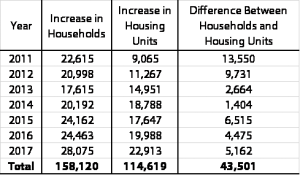Blog Post
Insight: A Note of Clarification on Utah’s Housing Shortage
By: James Wood
Realtors, home buyers, renters, and builders all agree: there are not enough housing units to meet demand. And their anecdotes are supported by housing market data. Typically the number of new housing units in a given year is slightly greater than the annual increase in households. In other words, annually we get more homes than households and the difference is explained by second homes and changes in vacancy rates. This decades old stable relationship, however has flipped since the Great Recession. The annual increase in households has exceeded housing units for the past several years creating a housing shortage. Utah is certainly not alone in facing a housing shortage. The shortage is a national problem and particularly acute in high growth states like Utah.[1] Since 2011, the number of households in Utah has increased by 158,100, but only 114,600 new housing units have been built, leaving a shortfall of some 43,500 dwelling units (see Table 1).
Table 1: Increase in Households Compared to the Increase in Housing Units in Utah

Source: Kem C. Gardner Policy Institute
How should this gap between demand and supply be interpreted? Where are those 43,500 households living? Are they homeless? The shortfall should be considered in terms of housing supply rather than demand. The immediate impact of the shortfall is to push down the vacancy rate for both rental and owner occupied housing. The effect is that potential renters and buyers have fewer choices. A healthy housing market has a five to six percent vacancy rate in rental housing and about two percent vacancy rate in owner occupied housing (unsold vacant homes for sale). In today’s market the vacancy rate for both the rental units and existing homes is near all-time lows. The rental vacancy rates in most markets in Utah is below four percent while the number of listings of existing home for sale is well below two percent. The strongest evidence of the scarcity of “for sale” existing homes is the alarmingly low “days on market” for sold homes. Of the 22,145 homes sold in Utah between January and June of 2018, the median number of days from listing to sale was 15 days.
Probably close to half of the 43,500 shortfall in housing units has been absorbed by what would normally be vacant units in a healthy housing markets. The result is an extremely “tight” housing market with fewer housing opportunities for buyers and renters. The remaining shortfall has not led to homeless households but rather doubled-up households.[1] Many of those households unable to find housing, due to the shortage, are living in shared household arrangements. American adults are increasingly sharing a home with other adults with whom they are not romantically involved. This arrangement, known as “doubling-up” or shared living gained notice in the wake of the Great Recession, and nearly a decade later, the prevalence of shared living has continued to grow.[2]
In recent months, Utah’s housing shortage has been discussed in the media. The Salt Lake Tribune mentioned that recent studies estimate the housing shortfall at 250,000 dwelling units.[3] The source of the estimate was not citied but a shortfall of 250,000 units is far too high. To give some context to that high estimate, there is a total of about 950,000 occupied housing units in Utah. Perhaps the 250,000 estimate was referring to a shortage of affordable housing but even in that case the estimate is too high. Regarding affordable housing, there are approximately 100,000 Utah households currently paying more than 50 percent of their income for housing. This estimate demonstrates the need for affordable housing and the housing crisis 10 percent of Utah households face, but the need for affordable housing and Utah’s housing shortage, while related, are two separate issues.
The housing shortage impacts are well-known and challenging: lower vacancy rates, an increased number of doubled-up households, and higher housing costs. These conditions probably won’t get worse in 2018 as the level of residential construction activity increases. Between January and May 2018, the number of permits for new dwelling units is at the highest level since 2006. There is a very good chance that as many as 27,000 residential units will be approved in 2018, which is equal to the number of new households expected this year.
James Wood is the Ivory-Boyer Senior Fellow at the University of Utah.
[1] “Doubled-up households are defined as having one or more adults in addition to the head of household and spouse or partner, such as an adult child living at home, two related or unrelated families residing together, or a parent living with an adult child,” U.S. Census Bureau.
[2] “More adults now share their living space, driven in part by parents living with their adult children”, by Richard Fry, Pew Research Center, 2018.
[3] “Half of Utah voters OK with surge in housing,” Salt Lake Tribune, July 5, 2018.
[1] “The Large Unmet Demand for Housing,” by Jordan Rappaport, The Macro Bulletin, Federal Reserve Bank of Kansas City, April 12, 2017.






